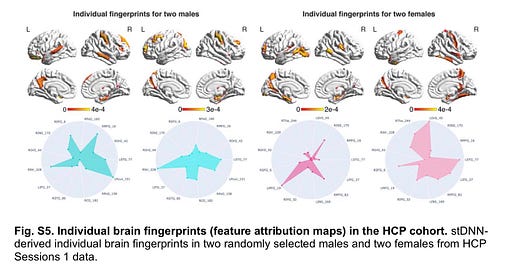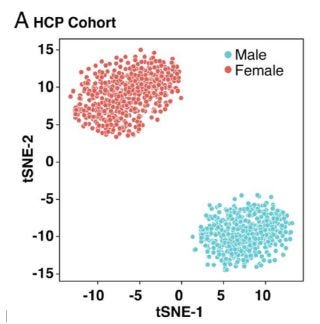The two human minds
A dramatic finding regarding sex differences in thinking (which of course is being ignored for reasons of 'society would fall apart')
An article in Psychology Today from last month has come across my feed today. Typically, I do not mention ‘science news’ coverage of studies except to set up the over-simplified representation of the study for critique: Here, the headline and review by author Leonard Sax is accurate: “New Research Finds Huge Differences Between Male and Female Brains.”
I might also normally use a study like this as an opportunity for meta-commentary on the ironies of intelligence and demographic research: Human thinkers, before the advent of feminism, tended to regard sex differences in the mind as obvious truths — as things that were apparent from mere observation of how people behave individually and within society. If modern “science” suddenly offers evidence that supports these previous observations, that only demonstrates that what is obviously true is… actually true. The discernment of intelligent men is a valid tool for apprehending the world, even when it contradicts the fantasies which have been woven into the present social consensus of reality through politeness and Hollywood propaganda: The reason people of the past and present have believed groups of people are different is because they (observably) are.
But instead, I’m just going to report on the study itself. It has a hidden, interesting aspect, which is that their deep learning model learned how to predict intelligence from MRI scans: So “the computers can scan people’s brains for intelligence” is a thing which exists now, and will presumably be put into practice if AI ever becomes sentient.
Overview
The study was published in February, to scant media attention: Ryali, et al., “Deep learning models reveal replicable, generalizable, and behaviorally relevant sex differences in human functional brain organization.” Although it is paywalled, the methods are described extensively in a downloadable appendix.
The authors used Human Connectome Project, a large, pre-existing library of (multi-session) MRI scans of young adults, to train a “spatiotemporal deep neural network (stDNN) model” to recognize male and female patterns of activity. They then tested the models discernment on two other libraries. They also performed a bunch of other validation within the first model, and etc. The end result put simply was that the model could tell when images not used in the training set belonged to women or men, even if the images used to train and test it were swapped around and etc.: what mattered is that women did not exhibit male patterns, and men did not exhibit female patterns.
How different?
As said, Sax’s review is a mostly accurate representation of the study, but does overstate the nature of the differences between women and men. The learning model is able to label different patterns of activity, and associate such patterns with each other, such that male and female scans can be scored in two dimensions by the “distance” to which their images have certain associated patterns. In such a plot, there is no “overlap” between male and female scans:
Sax reports this as if it refutes two claims used to argue that sex differences in thinking are real but not binary; one being that there is “a lot of overlap” with male and female ways of thinking. This would depend on how someone debating the topic means overlap.
When the learning model is identifying certain patterns as male and female, it is constructing the “fingerprints” of brain activity that are exhibited individually and in the group level by each sex. These fingerprints may have some overlap; but males will have the unique aspects which prompt them to score a certain “distance” toward one end of the 2-D plot, females will have the unique aspects that score toward the other end. Of the five hundred in each sex who were scanned multiple times, none generated images that would land them in the wrong herd.
In amalgamation, this does refute the second claim mentioned by Sax: Male and female ways of having the lights on in their brains are not a “continuum.” They are two different things, even if they must obviously have similarities. Just as there are many things which must be similar about male and female faces — there is only so much difference which can exist — they are still different. Just as men and women both have noses, and use them, they both have the same brain parts, and use them; just not in the same combinations. Minds would seem to be even more sex-binary than faces, but still there is certain to be a degree of fundamental similarity still at work; the distance would not appear so great if hummingbird brain scans were included in the 2-D plot.
How these different combinations of activity influence the act of thinking is not something a 2-D plot can describe, because “thoughts” are not being qualified or discerned by the scans. These remain internal to the consciousness of women and men, and thus regular human observation remains the best insight into this feature of the human condition.
The same cannot be said for intelligence.
The sex-specific “intelligence scan”
The MRI library used to train the model was accompanied by scores for 14 types of cognitive tests. For both males and females, the model was able to use these scores to train on which “fingerprints” resulted in higher scores. Certain sub-patterns correlated very highly with the IQ-related tests, another with the tests for behavioral inhibition, and another with tests for reward-related self-regulation. (See page 21 of the appendix for the correlation scores for these three different models for each test, and page 37 for a description of the tests.)
The model was able to tell which male fingerprints would likely score more highly on the cognitive tests, and likewise which female fingerprints. Naturally neither of these trained “intuitions” performed well for the opposite sex; given that women and men had dissimilar fingerprints, it wouldn’t be possible for men to exhibit the “smart female fingerprints” or vice-versa.
While Ryali, et al. (the authors of this study) must certainly have done impeccable work in designing their learning model, it’s important to note that these findings stem from a basic reality: People who would score certain ways on cognitive tests think with similar patterns of “lit up brain regions.” Even if this study is ignored or retracted over some complaint or other, that fundamental fact will remain immutable (unless in fact these results are fabricated on the absolute most superficial level). Any future well-designed learning model would encounter the same patterns and discern the same truths about likely test scoring.
Conversely, this validates that the types of tests used for cognitive performance, such as English language tests, correspond to an underlying physical reality that doesn’t depend on taking the test. (I believe similar findings have been found for genes, in that gene “fingerprints” trained on Westerners turn out to be valid even for other groups. But I am not as interested in gene-based group analysis.)
Related:
If you derived value from this post, please drop a few coins in your fact-barista’s tip jar.











Thanks Brian, a favorite subject, new material for me.
Do you know, along the original division of labor line of male and female, this book by Melvin Konner "Women After All", excellent.
https://www.amazon.com/Women-After-All-Melvin-Konner-MD-audiobook/dp/B011QH5OGK/ref=sr_1_1
Get free, stay free, first for the Mothers then for the Others.
(See Lloyd deMause "The Origin of Wars in Child Abuse" www.psychohistory.com )
https://www.researchgate.net/publication/222143648_The_golden_mean_as_clock_cycle_of_brain_waves